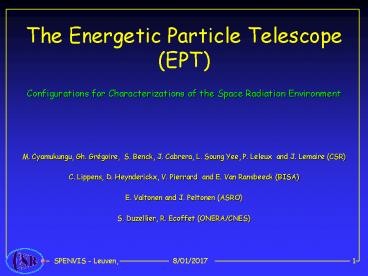The Energetic Particle Telescope (EPT)
Title:
The Energetic Particle Telescope (EPT)
Description:
The Energetic Particle Telescope (EPT) Configurations for Characterizations of the Space Radiation Environment M. Cyamukungu, Gh. Gr goire, S. Benck, J. Cabrera, L ... –
Number of Views:119
Avg rating:3.0/5.0
Title: The Energetic Particle Telescope (EPT)
1
The Energetic Particle Telescope (EPT)
Configurations for Characterizations of the Space
Radiation Environment
- M. Cyamukungu, Gh. Grégoire, S. Benck, J.
Cabrera, L. Soung Yee, P. Leleux and J. Lemaire
(CSR) - C. Lippens, D. Heynderickx, V. Pierrard and E.
Van Ransbeeck (BISA) - E. Valtonen and J. Peltonen (ASRO)
- S. Duzellier, R. Ecoffet (ONERA/CNES)
2
Contents
- Basic principle of the EPT
- Particle channels Detection efficiencies
- The EPT configurations
- The EPT Development status
- The EPT and SPENVIS
- Flight opportunity
- The EPT development team
- Conclusions
3
1. Basic principles of the EPT
4
2. Detection efficiency (ctd)
5
2. Detection efficiency (ctd)
Protons
6
2. Detection efficiency (ctd)
a - particles
e72
7
3. The EPT configurations
3.1. Low flux particle detector
8
3.1.1. Low flux particle detector large F.O.V.
angle for flux
measurements on board non-spinning satellites
9
3.1.2. Low flux particle detector reduced
F.O.V. angle for flux
measurement on board spinning satellites
10
3.2. High flux particle detector
3.2.1. High flux particle detector variable
aperture / F.O.V. angle
11
4. The EPT and SPENVIS
12
5. The EPT development status
The (high flux) EPT prototype is being finalized
and will be tested in november 2005. This
test will be followed by that of silicon sensors
( and half EPT) in january 2006.
13
6. Flight opportunity
- The EPT schedule is drawn to fit into the
development plan of the Environmental Explorer
mission (NRL project)
- The consortium is also interested in acquiring
data on board Alphasat
14
7. The EPT development team
The EPT development was initiated in 1997 by
Prof. Gh. Grégoire and Dr. M. Cyamukungu. The
development of the DAMs was supported by the
Nuclear Physics Institute and the hardware for
the prototype under construction was funded by
the Belgian Institute for Space Aeronomy. The
construction of an Engineering Qualification
Model is undertaken by an international team
including skills from
CSR Belgium
BISA Belgium
Aboa Space Research Oy Finland
ONERA/CNES France
With collaboration from NRL (USA) and Aerospace
Corporation (USA)
15
Conclusions
The Energetic Particle Telescope (EPT) can
be configured to measure particle fluxes in
several radiation environment conditions. Its
main features are
- outstanding particle discrimination capability
- high data acquisition rates due to digital
operation mode - almost no background counting
- extended energy range covered by a single
instrument - digital reliability and built-in redundancy































